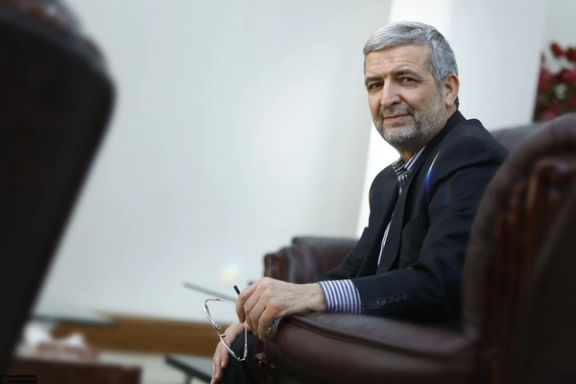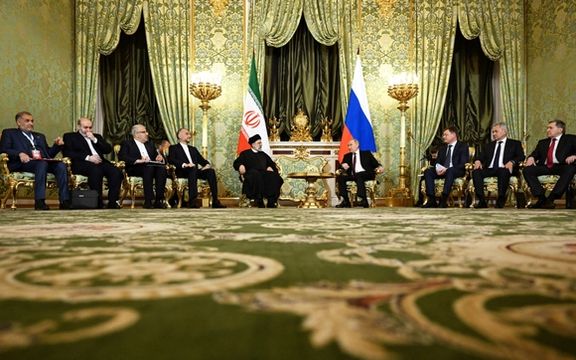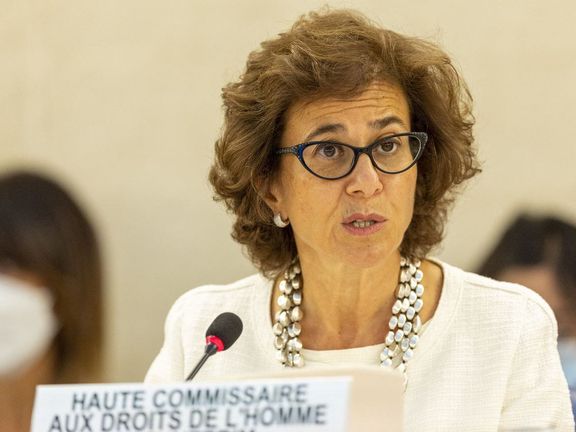Slain Militants From Iran-Backed Fatemiyoun Division Buried In Mashhad

The bodies of five militants from the Iran-backed Fatemiyoun division were buried on Wednesday in the northeastern city of Mashhad.

The bodies of five militants from the Iran-backed Fatemiyoun division were buried on Wednesday in the northeastern city of Mashhad.
Identified by IRNA as Ali Hosseini (son of Amir), Ali Hosseini (son of Mohammad Hossein), Ali Hosseini (son of Ebrahim), Hamzeh Alavi, and Mohammad Ali Akbari, the militias were killed in the recent US attacks.
Reports from the Telegram channel Defenders of the Shrine indicated on Monday that four members of the Fatemiyoun, including Ali Hosseini, Hamzeh Alavi, Mohammad Ali Akbari, and Mohammad Reza Sadat Alavi, died in a recent US attack on Syria. The moniker Defender of the Shrine is associated with forces dispatched to Syria in support of President Bashar al-Assad's regime.
Ali Hosseini was a commander within the Fatemiyoun Brigade in eastern Syria. Images circulating onlineshow him alongside Qasem Soleimani, the former commander of the IRGC’s Quds Force who was killed by the US in 2020.
The Sunday US military's strike on Iran-affiliated militias in eastern Syria occurred as the US has increased strikes against Iran-backed forces in retaliation to the killing of American soldiers in Jordan. Last week, three US service members lost their lives in drone attacks perpetrated by Iran-backed groups in northeastern Jordan, the first American fatalities since Iran’s proxies has come out in allegiance with Hamas in Gaza.
The Fatemiyoun Brigade, operating under the auspices of the Quds Force of the Revolutionary Guards, comprises Afghan immigrants in Iran and has been actively deployed in Syria in recent years. Criticism of Iran's recruitment tactics has been pervasive, with observers and human rights activists condemning the exploitation of Afghan refugees' dire circumstances to engage in regional conflicts, including the ongoing conflict in Syria.

Ebrahim Raisi's special envoy for Afghanistan has claimed that Iran has fighters ready to support the war in Gaza amid its regional proxy war against Israel and the US.
In an interview with the Afkar Network, Hassan Kazemi-Qomi said, "Although Afghanistan is farther from Gaza, if necessary, more than one brigade from this country will go to support Gaza."
Iran-backed Hamas invaded Israel on October 7 in what was the most deadly single day for Jews since the Holocaust. Since then, Israel's relentless retaliation and the US support for its right to defend itself has sparked a regional proxy war. Iran's militias in Syria, Lebanon, Iraq and Yemen have joined the fight in support of Hamas in Gaza.
Kazemi-Qomi's statement comes after the Iranian regime launched a multi-platform campaign to recruit fighters for the Hamas conflict against Israel. Despite Iranians branding it as a propaganda stunt, the regime initiated the campaign through various outlets including websites affiliated with the Revolutionary Guards and the state broadcaster.
A chyron message urging viewers to sign up and declare their readiness to be dispatched to Palestine aired during broadcasts. Additionally, Iranians received SMS messages prompting them to express their willingness to participate. The regime also established a website named "al-Aqsa Storm," mirroring Hamas's codename for its offensive into Israel, which claimed numerous civilian and military casualties, alongside the taking of hostages.
Iran's proxies are mostly made up of fighters from Shia Muslim–majority countries such as Iraq and Lebanon but Shia groups in Sunni-majority Afghanistan, its border neighbor, the

Iran's Foreign Investment Organization CEO claims the country has attracted $10.6 billion in “foreign investment” since President Ebrahim Raisi assumed office in August 2021.
Ali Fekri stated that almost half of this figure is related to the oil and gas sector, with Russia leading other foreign investors with $2.7 billion in funds.
He went on to say that the attracted investment value during the last fiscal year, from March 2022 to 2023, was $4.2 billion. However, according to the United Nations Conference on Trade and Development (UNCTAD), Iran attracted only $1.5 billion in foreign direct investment in 2022.
Fekri's claim about $10.6 billion in "foreign investment" came after he recently cited the figure of $9.2 billion in an interview with the semi-official Tasnim news agency on November 23, 2023.

He explained at the time that the figure doesn’t mean $9.2 billion foreign cash funds flowed into the country; rather, it is the amount of "approved investment projects and contracts by foreigners" since the start of the Raisi administration. In simpler terms, what he refers to as "attracted foreign investment" is indeed the value of contracts with foreigners.
Fekri also mentioned that during the last fiscal year ending March 21, 2023, Iran attracted $4.2 billion in foreign investment, about 170% more than the previous year. However, UNCTAD's statistics do not indicate any significant investment inflow to Iran during 2022 compared to 2021.
He did not elaborate on why his claimed "attracted investment value" increased from $9.2 billion to $10.6 billion since November 2023, especially considering that Iran has not announced any new contracts with foreigners in the last three months. He named Russia, China, UAE, and Turkey as the biggest "investors" in Iran since August 2021.
Russian 'Investment'
Regarding Russian "investment," his claim about attracting $2.7 billion in investment came while Russian companies have only sealed contracts to drill wells in seven Iranian oil fields. This represents service exports rather than investment contracts. For example, one of these companies, Russian ZN Vostok Ltd., is obligated to drill 20 wells and install 22 pumps in the Cheshme Khosh oil field. Its CEO, Azamat Faridovich Ismagilov, stated that the total value of contracts with Iran is $500 million, including $170 million for the Cheshme Khosh field.
It’s CEO, Azamat Faridovich Ismagilov said on February 6 that ZN Vostok’s total value of contracts with Iran is $500 million, including $170 million on Cheshme Khosh field. “We have three drilling rigs in Iran and have a plan to add another one for drilling 6 new wells”.
ZN Vostok signed the contract with Iran in April 2022 to develop the above-mentioned field. It has increased the field’s production by 29% to 62,000 barrels per day so far by drilling 14 wells.
Iran has a history of exaggerating cooperation levels with its "anti-western" partners like Russia and China, especially when good economic news becomes scarce and the national currency, rial, nosedives. Since the beginning of January the rial has lost more than 10 percent of its value against the US dollar and other major currencies.
For instance, while Iran proudly announced the signing of the "largest oil and gas agreements in the country's history worth $40 billion” with Russian Gazprom in 2022, Morteza Behruzifar, an energy expert in Tehran told the ILNA news website that even before the Western sanctions on Russia, it had not invested a penny in Iran.
Like most Russian companies, Gazprom is hardly in a position to invest in another country. Its revenues plunged to $3.1 billion in the first half of 2023, from $16.5 billion in 2022.
Although Gazprom plans to invest $17.5 billion in 2024, 20 percent less than 2023, none of its mentioned investment are related to Iran.

Mehrad Ebad, a member of the Iranian Chamber of Commerce, has voiced concerns over the volatility of Iran's national currency.
He stated on Wednesday that, "Nowhere else in the world does the national currency's value drop by 20% overnight."
In the address, he added, “Economic stability is one of the most crucial needs for businesses, enabling their owners to plan based on this stability. Unfortunately, in recent decades, stability has been lacking in the Iranian economy, and domestic and international events with direct and indirect impacts on Iran's economy have influenced the exchange rate.”
The Iranian rial's recent nosedive against the US dollar has exacerbated the concerns. Last week, the rial plummeted to 575,000 against the dollar amidst escalating regional tensions and uncertainties surrounding the US presidential election, particularly regarding the potential re-election of Donald Trump.
Although the rial has regained some of its value in the past few days, reaching 557,000 against the dollar, the overall trend remains worrying. Since 2018, the currency has depreciated 13-fold, triggered by the US withdrawal from the JCPOA nuclear deal and subsequent sanctions on Iran's oil exports and international banking.
With an annual inflation rate exceeding 50 percent, the diminishing value of the rial is expected to exacerbate inflationary pressures in the coming months. The economic instability is compounded by low monthly wages for workers, averaging less than $200, leading to widespread discontent and protests across various sectors, including oil and gas production platforms and refineries.

The Deputy UN Commissioner for Human Rights has visited Iran in total media silence after Iranian opposition urged her to cancel or postpone her visit in protest to Iran's recent executions.
Neither the Iranian authorities, nor the UN Human Rights Office have issued statements regarding Nada Al-Nashif’s visit, which took place between 2 to 5 February as scheduled. However, in an email to Voice of America (VOA) on Monday, rights office spokesperson Ravina Shamdasani confirmed that Al-Nashif arrived in Iran on Friday, with her departure scheduled for later on Monday.
The UN Human Rights Office has yet to respond to Iran International’s inquiries about the media silence surrounding the visit by both sides, and the objectives achieved during her time in Tehran.
Last week, the office of the UN High Commissioner for Human Rights assured that the planned visit of the deputy high commissioner to Iran would not compromise their reporting and advocacy efforts, despite criticisms.
Responding to Iran International on Saturday, the UN Human Rights Office acknowledged concerns raised by Iranian and other rights activists over the visit. They stated that the visit, initially scheduled for 2020 but delayed due to various factors including the COVID pandemic, aimed to discuss critical human rights issues such as the death penalty and women's rights.

The Human Rights Office said the aim of Al-Nashif’s visit was “to discuss critical human rights issues, including the death penalty and rights of women, as well as Iran’s obligations under international human rights law as a state party to a number of treaties” and added that the visit would entail meeting with relevant state interlocutors, including judicial officials, and UN partners.
“Our mandate requires us to seek all avenues to promote States’ compliance with their international human rights obligations,” the Human Rights Office said.
The timing of Al-Nashif's visit, following Iran's recent executions and a surge in human rights abuses, raised concerns that the Islamic Republic might exploit it for propaganda purposes. Rights activists, including a coalition of 25 human rights organizations, called on Al-Nashif to postpone or cancel her visit in protest against the executions.
Iran executed four Kurdish prisoners on Monday, accusing them of collaborating with Israel. Rights organizations claim these executions were based on coerced confessions and lacked fair trials.
Another young man, a protester, was hanged on January 23 although his death sentence had been overturned by the Supreme Court and a retrial had been ordered, due to gross violations in his first trial. Recent weeks have seen an average of three executions per day in Iran.
The coalition of 25 human rights organizations expressed suspicions that Iranian authorities might exploit the visit to undermine international mechanisms critical to human rights promotion and protection in Iran.
“The visit will not undermine our approach in terms of reporting and advocacy. We hope that our combined advocacy and engagement contribute to progress towards strengthened alignment with international human rights standards,” the Human Rights Office responded about such concerns while stressing that its dialogue with the authorities allows them to follow up on all recommendations emanating from human rights mechanisms, including special procedures and fact-finding missions.
The United Nations’ Human Rights Council appointed an independent fact-finding mission in November 2022 to review Iran's human rights violations during the Woman, Life, Freedom movement that began in mid-September and spread throughout the country but was brutally crushed by killing around 500 civilians and arresting tens of thousands of protesters.
The Islamic Republic said it would not allow an independent investigation into the protests and has refused to cooperate with UN human rights rapporteurs since 1992.

A Swedish Radio investigation has revealed that two Iranians were deported following a murder plot to kill Swedish Jews.
A Swedish Radio investigation has revealed that two Iranians were deported following a murder plot to kill Swedish Jews.
The couple, Mahdi Ramezani and Fereshteh Sanaeifarid, who had entered Sweden in 2015 on forged Afghan passports seeking asylum, were deported in 2022 after their arrest in 2021.
They had targeted three Swedish Jews including Aron Verständig, Chair of the Official Council of Swedish Jewish communities, who was informed of the plot in 2021. One of the other potential targets was a dual US citizen, according to the Swedish Radio report.
The suspects, believed to have been part of an IRGC plot, lived under fake identities in the country.
“I think that what Iran wants to do is to harm Israel and I think it’s very difficult for them to do these kinds of things in Israel. So instead they are randomly choosing people who have some kind of official position in the Jewish diaspora and trying to create fear," Verständig told the radio station, though it is unclear why the case has only gone public now.
Deputy chief prosecutor Hans Ihrman said the FBI in the US was also investigating the couple. While there was not enough evidence to prosecute in Sweden, Ihrman said: “We have strong belief that they were here on a mission on behalf of Iran. They were seen here in Sweden as a very severe security threat. And that's the reason why they were expelled, even if we couldn't prosecute them."
Jews and Israelis abroad have increasingly been targets of the regime in recent years, plots foiled in countries including Greece, Cyprus, Azerbaijan and Argentina.
Last year, Sweden's parliament voted to designate the IRGC and relations between the two countries are ever more strained since 2019 and the arrest of a former Iranian jailor, Hamid Nouri. Sweden sentenced him to life imprisonment last year over executions of political prisoners in 1988.
A series of high profile arrests of Swedish citizens has followed as Iran's hostage-diplomacy continues.